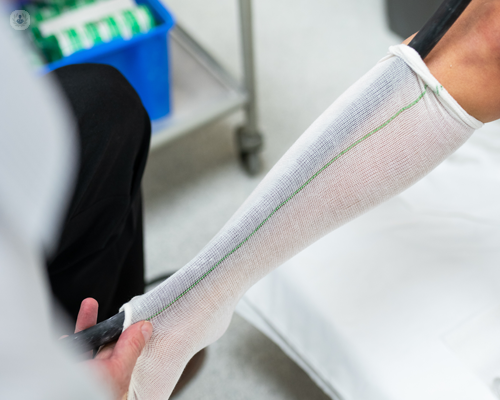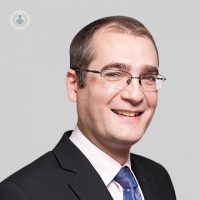Treating varicose veins using ultrasound guided foam sclerotherapy
Escrito por:There are various ways to treat varicose veins. Leading vascular surgeon Mr Martin Claridge talks us through ultrasound guided foam sclerotherapy (UGFS); answering queries about the treatment, its side effects and more.

What is ultrasound guided foam sclerotherapy?
A well-established method for treating varicose veins is ultrasound guided foam sclerotherapy. UGFS is particularly effective at treating:
(a) trunk varicose veins which develop near the surface of the skin and are thick and lumpy;
and;
(b) less lumpy reticular veins which lie in the deeper layers of the skin.
UGFS is recognised as the most convenient and cost-effective treatment for varicose veins, and can be used on its own or to complement other treatments for varicose veins.
What does the treatment involve?
Foam sclerotherapy is performed using local anaesthetic and is an outpatient procedure. It usually takes less than an hour. The focus of the treatment is for veins to shrink and eventually disappear.
The foam sclerosant is made by mixing the sclerosing liquid with air and then injected into the veins through very small plastic tubes. This causes the veins to block up and the body will then absorb the veins so that they dissolve away.
An ultrasound scanner is used as a guide, which ensures these tubes are placed accurately and safely in the veins that are going to be treated. The tubes are removed once all the veins have been treated and area is then dressed with compression pads, a bandage and an elastic compression stocking. You will be given a spare compression stocking.
How long does UGFS take to work and is it safe?
Most patients report an improvement in the appearance of their legs at four weeks, although it can take six to 12 months to realise the full cosmetic benefits. The incidence of side effects and complications is very low, and can include:
- Allergies
Very rare; mild allergic reactions have been reported.
- Bruising
There is very little bruising normally; any disappears within a few weeks.
- Pigmentation
Brown streaks may develop over the area where the varicose veins existed for a small proportion of patients. This pigmentation gradually fades over six to 12 months.
- Lumps
Some lumpiness, particularly where the varicose veins were large, will still be felt beneath the skin. This is quite normal and usually disappears within six to 12 months. Often, this can be reduced by withdrawing a small volume of trapped blood from the treated vein two to three weeks after treatment.
- Headache
Headaches can occur very occasionally. It is more common in patients that suffer from migraines. Paracetamol or other simple pain relief can be used for treatment, if necessary.
- Thrombophlebitis
Some patients may develop a painful red lump over the position of one or more of the varicose veins that have been lumpy. This is called superficial thrombophlebitis, which can be treated with anti-inflammatory medication such as ibuprofen. It will settle down after one or two weeks.
- Thrombosis
The risk of developing a deep vein thrombosis is small; one in 200 or 0.5 per cent. It is very rare that a piece of thrombus may travel to the lungs causing a pulmonary embolus
- Stroke
Strokes are extremely rare. Despite there being only handful of cases reported around the world, each patient made a full recovery.
- Other side-effects
These rare events include:
- Ulcers
- Transient visual disturbance
- Coughing
- Chest tightness
How long does UGFS treatment last?
It takes approximately 45 minutes to an hour to treat one leg.
What should patients expect during the treatment?
UGFS is one of the most convenient treatments to undergo. It really is like a having a few blood tests in your leg. You should expect to lie on a couch whilst the treatment is performed and only feel discomfort when local anaesthetic is administered.
What do patients have to do after the procedure?
It is recommended that you keep the compression pads, bandage and stocking on the leg for three to five days depending on the size of the veins. The pads and bandage can then be removed after this time. However, the stocking should be worn day and night for a further seven days and then during waking hours for a further two weeks.
Returning to normal activities and regular daily exercise is beneficial and recommended. You should be able to return to work immediately but driving is best avoided on the day the procedure takes place. If the right leg (used for making emergency stops) has been treated, it’s advised that you don’t drive whilst the bandage is in place. This is because it will make your ability to do an emergency stop difficult. Once the bandages have been removed, driving can be resumed. It's safe to return to driving the day after treatment when the left leg (clutch leg) has been treated.
One of the best exercises to is walking because it promotes the healing process and encourages blood circulation. It’s best to avoid more vigorous physical activities such as jogging or aerobics until after your review (follow-up appointment).
Swimming and cycling, which are low-impact exercises, are also good for the health of your veins. As long as you wear your compression stocking, swimming is fine once the bandages have been removed. At the end of your swim, you can change into a dry one.
Avoid strenuous cycling until after your review. For six weeks after treatment, you should avoid flying, especially if you’re planning to fly long haul (over eight hours).
Make an appointment with Mr Claridge via his Top Doctors profile, here, for UGFS or other vascular treatments.


